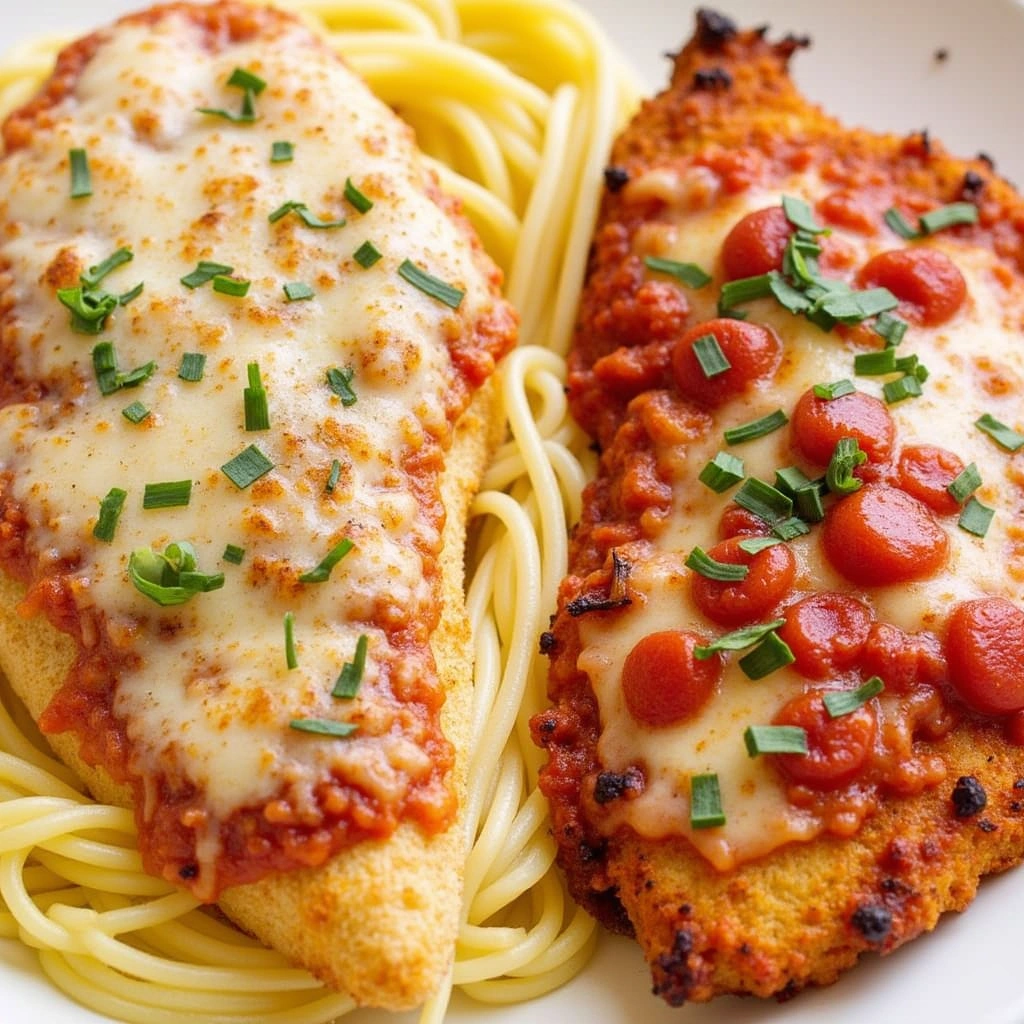Origins and Key Differences: Chicken Parmesan vs. Chicken Parmigiana
Introduction
Chicken Parmesan and Chicken Parmigiana are iconic comfort dishes that have delighted diners around the world with their rich flavors and satisfying textures. Both dishes feature breaded, fried chicken smothered in marinara sauce and topped with melted cheese, making them visually and conceptually similar. However, their origins and subtle differences often lead to confusion, especially among those less familiar with their culinary backgrounds.
The primary distinction lies in their roots: Chicken Parmigiana is a traditional Italian creation, while Chicken Parmesan is an Americanized adaptation that emerged through the influence of Italian immigrants. Despite their shared foundation, variations in preparation techniques, cheese selection, and serving styles set these dishes apart.
In this exploration, we’ll delve into the historical origins of Chicken Parmigiana and Chicken Parmesan, examine their distinct characteristics, and uncover how regional influences have shaped these beloved classics.
Table of Contents
Historical Origins
Chicken Parmigiana
Chicken Parmigiana, known in Italian as “parmigiana di pollo,” traces its roots to southern Italy, particularly the Campania region. The dish is believed to have originated as a variation of eggplant parmigiana, a classic Italian recipe that features layers of breaded and fried eggplant, tomato sauce, and Parmesan cheese. The use of chicken in place of eggplant is thought to have emerged in the early 20th century as a creative adaptation to meet the preferences of meat lovers.
Traditional Chicken Parmigiana emphasizes authentic Italian flavors, including a marinara sauce made from ripe tomatoes, garlic, olive oil, and fresh basil. The chicken is breaded with a mixture of breadcrumbs and grated Parmesan cheese, pan-fried until golden, and then baked to perfection after being topped with marinara sauce and more Parmesan.
In Italy, Chicken Parmigiana is often served as a standalone dish or paired with lighter pasta shapes like penne, allowing the rich flavors of the chicken to shine without overwhelming the meal.
Chicken Parmesan
Chicken Parmesan, or “chicken parm,” is an Italian-American adaptation of Chicken Parmigiana that gained popularity in the United States during the mid-20th century. Italian immigrants introduced the dish to American audiences, blending traditional techniques with locally available ingredients to create a heartier, more indulgent version.
Unlike its Italian counterpart, Chicken Parmesan often features a simpler breadcrumb coating without Parmesan cheese in the breading. Mozzarella cheese, known for its gooey and stretchy texture, is added to the dish, alongside Parmesan, to create a more decadent and visually appealing topping.
Chicken Parmesan is commonly served with a side of spaghetti, reflecting American preferences for large, carb-heavy meals. Over time, the dish has become a staple in Italian-American restaurants, celebrated for its robust flavors and comforting appeal.
Key Differences between chicken parmesan and chicken parmigiana
Breading and Cheese
One of the most notable differences between Chicken Parmigiana and Chicken Parmesan lies in the breading and cheese used.
- Chicken Parmigiana: The breading typically includes a mixture of breadcrumbs and finely grated Parmesan cheese, which creates a flavorful, crispy crust. The inclusion of Parmesan in the breading adds a nutty and savory depth to the dish, staying true to its Italian roots.
- Chicken Parmesan: The breading is often simpler, made with plain breadcrumbs or panko, without Parmesan cheese. This results in a lighter crust that serves as a base for the dish’s heavier cheese topping.
Cheese Toppings
The choice of cheese is another key distinction.
- Chicken Parmigiana: Parmesan cheese takes center stage, both in the breading and as the primary topping. Its sharp, nutty flavor complements the marinara sauce and enhances the overall taste of the dish.
- Chicken Parmesan: A combination of mozzarella and Parmesan cheese is typically used. Mozzarella’s gooey texture adds a layer of indulgence, while Parmesan provides a hint of sharpness. This combination caters to the American palate, which favors rich and cheesy comfort foods.
Sauces and Serving Styles
Both dishes feature marinara sauce, but their serving styles differ significantly.
- Chicken Parmigiana: The marinara sauce is light and fresh, often paired with penne or other lighter pasta shapes. In some cases, it is served without pasta to let the chicken stand out as the star of the dish.
- Chicken Parmesan: The marinara sauce is typically heartier and thicker, designed to coat spaghetti generously. This serving style reflects American preferences for robust, filling meals.
Cooking Techniques
While frying is a common preparation method for both dishes, there are subtle differences in technique:
- Chicken Parmigiana: The chicken is pan-fried in olive oil, imparting a rich, authentic flavor. After frying, the chicken is baked briefly with marinara sauce and Parmesan to meld the flavors.
- Chicken Parmesan: In American kitchens, baking is a more common preparation method to simplify cooking and reduce oil usage. Some recipes skip frying altogether and bake the breaded chicken directly, offering a lighter alternative.
Recipes, Variations, and FAQs: between chicken parmesan and chicken parmigiana
Popular Recipes for Each Dish : chicken parmesan and chicken parmigiana
Chicken Parmigiana
Chicken Parmigiana is a classic Italian dish known for its crispy breading, rich marinara sauce, and sharp Parmesan cheese.
Ingredients:
- 2 thin chicken breasts
- 1 cup breadcrumbs
- 1/2 cup grated Parmesan cheese
- 1 cup marinara sauce
- Olive oil for frying
Instructions:
- Prepare the Chicken: Pound the chicken breasts to an even thickness. Combine breadcrumbs and grated Parmesan in a shallow dish.
- Coat the Chicken: Dredge each piece in flour, dip in beaten eggs, and then coat with the Parmesan-breadcrumb mixture.
- Pan-Fry: Heat olive oil in a skillet over medium heat. Pan-fry the chicken until golden brown on both sides, about 3–4 minutes per side.
- Add Sauce and Cheese: Transfer the chicken to a baking dish. Top with marinara sauce and sprinkle generously with Parmesan cheese.
- Bake: Bake in a preheated oven at 375°F (190°C) for 10–15 minutes, until the cheese is melted and bubbly. Serve with penne or as a standalone dish.
Chicken Parmesan
Chicken Parmesan, the American counterpart, is heartier and cheesier, featuring mozzarella alongside Parmesan.
Ingredients:
- 2 chicken breasts
- 1 cup plain breadcrumbs
- 1 cup marinara sauce
- 1 cup shredded mozzarella cheese
- 1/4 cup grated Parmesan cheese
- Vegetable oil for frying
Instructions:
- Prepare the Chicken: Flatten the chicken breasts for even cooking. Season with salt and pepper.
- Bread the Chicken: Coat the chicken in flour, dip in beaten eggs, and dredge in plain breadcrumbs.
- Fry the Chicken: Heat vegetable oil in a skillet and fry the breaded chicken until golden and crispy.
- Assemble the Dish: Place the fried chicken in a baking dish. Spoon marinara sauce over the chicken and top with mozzarella and Parmesan.
- Bake: Bake at 400°F (200°C) for 15 minutes, or until the cheese is melted and bubbling. Serve with spaghetti for a complete meal.
Regional Variations and Modern Twists
Italian Variations
In Italy, Chicken Parmigiana is often prepared with simplicity and elegance:
- Traditional Ingredients: Thinly sliced chicken or veal is used, breaded with Parmesan and fried in olive oil.
- Serving Style: Parmigiana is commonly served as a standalone dish or paired with penne pasta to keep the meal light and balanced.
American Adaptations
The Americanized version of Chicken Parmesan is heavier and more indulgent:
- Cheese Overload: Generous amounts of mozzarella are used, creating a gooey, stretchy layer of cheese.
- Hearty Sides: The dish is frequently paired with spaghetti, garlic bread, or a crisp Caesar salad to cater to larger appetites.
Healthy and Creative Twists
Modern twists on these dishes offer healthier or more creative options:
- Baking Instead of Frying: Coat the chicken lightly with breadcrumbs and bake at 375°F (190°C) for a lower-calorie version.
- Gluten-Free: Substitute breadcrumbs with gluten-free alternatives or crushed almond flour.
- Vegetable Alternatives: Replace pasta with spiralized zucchini or spaghetti squash for a low-carb option.
These variations make the dishes more accessible to diverse dietary preferences while retaining their signature flavors.
Side Dishes and Pairings
Perfect Sides
- Garlic Bread: The crunchy, buttery texture of garlic bread provides the perfect contrast to the tender chicken and creamy cheese.
- Simple Salads: A mixed green salad with a balsamic vinaigrette adds a refreshing element to the rich flavors of the dish.
- Roasted Vegetables: Oven-roasted zucchini, asparagus, or bell peppers complement the meal’s savory notes while adding a healthy touch.
Beverage Pairings
- Red Wines:
- Chianti: This classic Italian wine’s medium-bodied profile pairs well with marinara sauce.
- Merlot: Its smooth, fruity flavor complements the richness of cheese and chicken.
- Non-Alcoholic Options:
- Lemon-Infused Sparkling Water: Adds a refreshing balance to the meal.
- Herbal Iced Tea: A subtle, non-distracting beverage option.
FAQs About Chicken Parmesan and Chicken Parmigiana
Are chicken parmesan and chicken parmigiana the same?
No, while similar in concept, Chicken Parmigiana is a traditional Italian dish, whereas Chicken Parmesan is an Americanized adaptation that caters to local tastes with extra cheese and heartier servings.
Which dish is more authentically Italian?
Chicken Parmigiana is considered more traditional to Italian cuisine due to its simpler preparation and use of authentic Italian ingredients like Parmesan and fresh marinara.
What cheese is best for each dish?
- Chicken Parmigiana: Parmesan cheese is the primary choice, delivering a sharp, nutty flavor.
- Chicken Parmesan: A blend of mozzarella and Parmesan is used for a gooey, indulgent texture.
Can I make these dishes healthier?
Yes, you can bake the breaded chicken instead of frying it to reduce fat content. Using whole wheat breadcrumbs or incorporating vegetable sides like zucchini noodles also makes the dish lighter.
Do Italians traditionally mix chicken with pasta?
Not commonly. In traditional Italian cuisine, chicken and pasta are typically served separately. The combination is more characteristic of Italian-American adaptations.
Both Chicken Parmigiana and Chicken Parmesan bring unique qualities to the table, allowing you to enjoy these iconic dishes in ways that suit your preferences. Whether you favor the authentic Italian simplicity of Parmigiana or the indulgent, cheesy comfort of Parmesan, there’s a version to satisfy every craving. Let me know if you’d like to expand on any section! 😊

